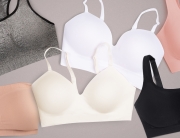Eye shadow (or eyeshadow) is a cosmetic applied primarily to the eyelids to attract attention to the wearer’s eyes, making them stand out or look more attractive.
Use
Eye shadow can add depth and dimension to one’s eyes, complement one’s eye color, make one’s eyes appear larger, or simply draw attention to the eyes. Eye shadow comes in many different colors and textures. It is usually made from a powder but can also be found in liquid, pencil, cream, or mousse form. Eye shadow can be applied in a wide variety of ways depending upon the desired look and the formulation. Typically application is done using fingers or brushes. The most important aspect of applying eye shadow, and makeup in general, is blending well. However, you must not forget to include a primer to limit the chances of creases in your eye shadow later.
To remove eye shadow, a commercial makeup remover can be utilized, though a rich face wash will usually remove all traces of color. Generally it is easy to remove, and simple water and soap can be used. Eye shadow, eyeliner, and mascara may also be removed using baby oil. There are also makeup wipes that can be used.
Ingredients
Eye shadows typically consist of four types of ingredients: base fillers, binders, slip, and preservatives. In order to make eye shadow, there must be a balance between the fillers and binders.Base fillers are usually minerals such as mica, talc or kaolin clay, which add bulk and texture to eye shadow. They make up about 30% of eye shadow powders and 25% of cream eye shadows. Mica absorbs moisture, gives the eye shadow shine and luster, and makes it opaque. Mica powders, iron oxides and clays can give color pigments to eye shadows.
Binders help eye shadow adhere and stay attached to skin. Eye shadows can have dry or liquid binders. Zinc and magnesium, which are both white powders, are commonly used as dry binders. Zinc also adds color and can be used to increase the thickness of the eyeshadow. Silicone, paraffin wax, mineral oil or vegetable oils may be used as liquid binders.Slip allows eye shadow to glide across the skin smoothly. Products may use silica or nylon, which are fine, colorless powders. Other types of slip include dimethicone, boron nitride or bismuth oxychloride.Preservatives help products stay bacteria free and extend their lifespan. Common preservatives in eye shadow are glycol and tocopherol.
Application
Eye shadow is usually applied with brushes, sponges or fingers. Different brushes can be used for different application techniques and effects, such as packing on eye shadow, blending, smudging or smoking out eye shadow, or applying color with precision or applying color below the eye.Flat brushes are typically used to pack eye shadow onto eyelids, while brushes with fluffy, tapered tips are used for blending eye shadows. Smaller brushes with dense or angled bristles are useful for precision work.
Photo Credit: Shutterstock







Add Comment